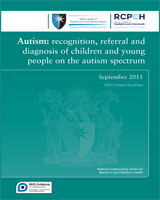Excerpt
This guideline covers the recognition, referral and diagnosis of autism in children and young people from birth up to 19 years.
The term ‘autism’ describes qualitative differences and impairments in reciprocal social interaction and social communication, combined with restricted interests and rigid and repetitive behaviours. Autism spectrum disorders are diagnosed in children, young people and adults if these behaviours meet the criteria defined in the International Statistical Classification of Diseases and Related Health Problems (ICD-10) and the Diagnostic and Statistical Manual of Mental Disorders DSM-IV Fourth Edition (Text Revision) (DSM IV-TR) and have a significant impact on function. The over-arching category term used in ICD-10 and DSM-IV-TR is pervasive developmental disorder (PDD), a term now used synonymously with autism spectrum disorder (excluding Rett syndrome): it is a behaviourally defined group of disorders, which is heterogeneous in both cause and manifestation.
The guideline development group recognised that individuals and groups prefer a variety of terms, including autism spectrum disorder, autistic spectrum condition, autistic spectrum difference and neuro-diversity. For clarity and consistency, in this guideline the term ‘autism’ is used throughout in keeping with the use of ‘autism’ in recent Department of Health, National Audit Office and Public Accounts Committee documents. However, in this guideline ‘autism’ refers to ‘autism spectrum disorder’.
While every effort has been made to ensure the accuracy of the information contained within this publication, the publisher can give no guarantee for information about drug dosage and application thereof contained in this book. In every individual case the respective user must check current indications and accuracy by consulting other pharmaceutical literature and following the guidelines laid down by the manufacturers of specific products and the relevant authorities in the country in which they are practising.
This guideline has been fully funded by NICE. Healthcare professionals are expected to take it fully into account when exercising their clinical judgement. However, the guidance does not override the individual responsibility of healthcare professionals to make decisions appropriate to the circumstances of the individual patient.
Implementation of this guidance is the responsibility of local commissioners and/or providers.


